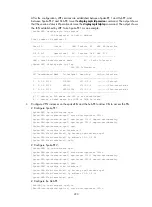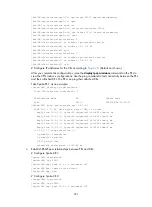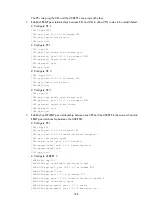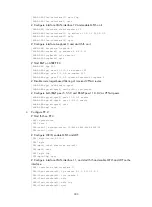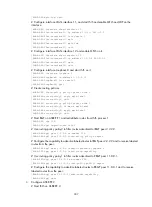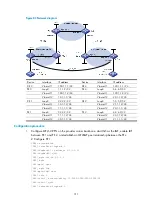
299
[ASBR-PE1-bgp-af-vpnv4] quit
[ASBR-PE1-bgp] quit
# Configure ASBR-PE 2.
[ASBR-PE2] bgp 200
[ASBR-PE2-bgp] ipv4-family vpn-instance vpn1
[ASBR-PE2-bgp-vpn1] peer 192.1.1.1 as-number 100
[ASBR-PE2-bgp-vpn1] quit
[ASBR-PE2-bgp] peer 4.4.4.9 as-number 200
[ASBR-PE2-bgp] peer 4.4.4.9 connect-interface loopback 0
[ASBR-PE2-bgp] ipv4-family vpnv4
[ASBR-PE2-bgp-af-vpnv4] peer 4.4.4.9 enable
[ASBR-PE2-bgp-af-vpnv4] peer 4.4.4.9 next-hop-local
[ASBR-PE2-bgp-af-vpnv4] quit
[ASBR-PE2-bgp] quit
# Configure PE 2.
[PE2] bgp 200
[PE2-bgp] peer 3.3.3.9 as-number 200
[PE2-bgp] peer 3.3.3.9 connect-interface loopback 0
[PE2-bgp] ipv4-family vpnv4
[PE2-bgp-af-vpnv4] peer 3.3.3.9 enable
[PE2-bgp-af-vpnv4] peer 3.3.3.9 next-hop-local
[PE2-bgp-af-vpnv4] quit
[PE2-bgp] quit
6.
Verify your configuration:
After you complete the configurations, the CEs can learn the interface routes from each other and
ping each other.
Configuring inter-AS option B
Network requirements
•
Site 1 and Site 2 belong to the same VPN. CE 1 of Site 1 accesses the network through PE 1 in AS
100 and CE 2 of Site 2 accesses the network through PE 2 in AS 600.
•
PEs in the same AS run IS-IS.
•
PE 1 and ASBR-PE 1 exchange labeled IPv4 routes by MP-IBGP.
•
PE 2 and ASBR-PE 2 exchange labeled IPv4 routes by MP-IBGP.
•
ASBR-PE 1 and ASBR-PE 2 exchange labeled IPv4 routes by MP-EBGP.
•
ASBRs do not perform route target filtering of received VPN-IPv4 routes.






